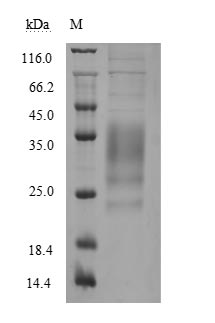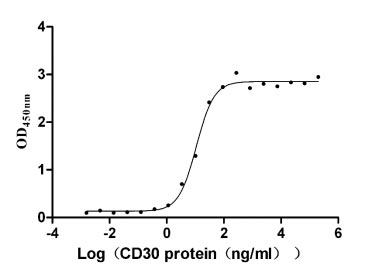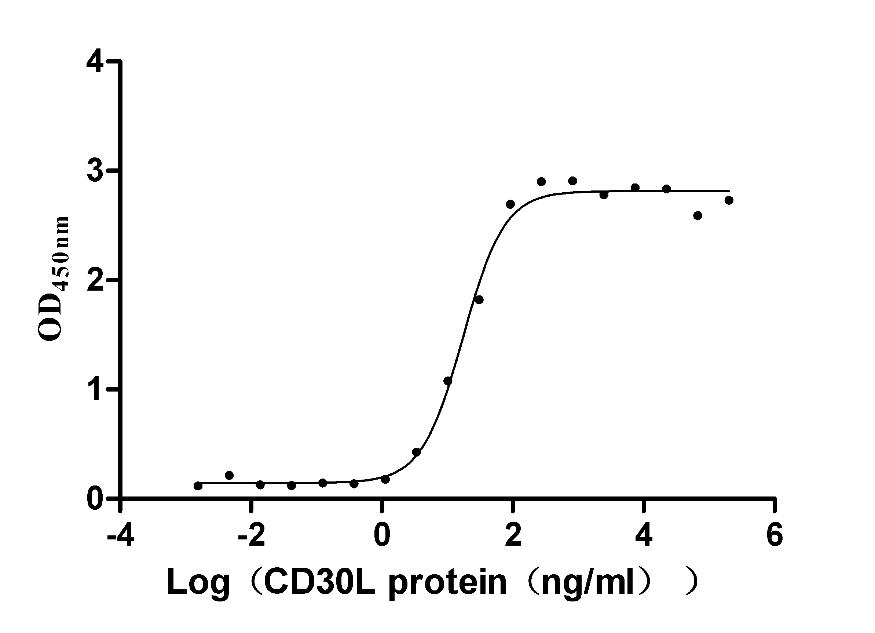The recombinant human TNFSF8 protein (CD30L) represents a biologically active form of this important immune signaling molecule, comprising the extracellular domain (63-234aa) of the TNFSF8 protein. Produced in mammalian cell expression systems with an N-terminal 6×His tag, this recombinant TNFSF8 protein demonstrates >85% purity by SDS-PAGE analysis and contains minimal endotoxin contamination (<1.0 EU/μg by LAL method), making it suitable for sensitive immunological studies. Functional validation through ELISA demonstrates specific, high-affinity binding to immobilized CD30 (CSB-MP023983HU1h6) with an EC50 range of 9.531-12.49 ng/ml, confirming its biological activity in receptor- ligand interactions. The N-terminal 6×His tag facilitates efficient purification while maintaining the protein's native conformation and functionality.
Presented as lyophilized powder, this recombinant TNFSF8 preparation offers excellent stability and convenient handling properties. The mammalian expression system ensures proper protein folding and post-translational modifications critical for maintaining the structural and functional integrity of this TNF superfamily member. This reagent is particularly valuable for investigating CD30-CD30L signaling pathways in immune regulation, lymphoma biology, and therapeutic development. Its demonstrated binding activity makes it suitable for functional studies of this important costimulatory pathway in both physiological and pathological contexts.
The TNFSF8 protein, also known as CD30L, is a member of the TNF superfamily that plays a significant role in immune regulation and apoptosis. Its primary function involves interaction with the CD30 receptor, which is predominantly expressed on activated T cells and B cells. This interaction is critical for promoting cell differentiation and regulating immune responses [1][2], and it has been implicated in various inflammatory and autoimmune diseases, such as rheumatoid arthritis and inflammatory bowel disease [3].
Functionally, TNFSF8 is particularly notable for inducing apoptosis in CD30+ cells. This process helps regulate immune inflammation, thus maintaining the balance required for effective immune responses [1][4]. The expression of TNFSF8 on various immune cells—including activated T cells, B cells, mast cells, and monocytes—highlights its pivotal role in orchestrating the immune response [2][5].
In addition to its immune regulatory functions, TNFSF8 has emerged as an important biomarker in certain cancers. For instance, its expression levels have been associated with patient responses to therapies such as immunotherapy and chemotherapy in conditions like pancreatic cancer and lung cancer, where alterations in TNFSF8 expression can predict therapeutic outcomes [6][7]. Specifically, higher levels of TNFSF8 have been linked to better responses to PD-1 inhibitors, indicating its significance in cancer prognosis [6].
Furthermore, genetic variations within the TNFSF8 gene have been associated with susceptibility to various diseases, reinforcing its relevance in both therapeutic and diagnostic contexts. These polymorphisms may modulate the gene's expression, consequently affecting individual responses to inflammatory conditions and cancers [3][8]. Studies have highlighted the complex interplay between TNFSF8 and other immune-related genes, illustrating its centrality in both innate and adaptive immune responses [9].
References:
[1] M. Qu, S. Wan, et al. The whole blood dna methylation patterns of extrinsic apoptotic signalling pathway-related genes in autoimmune thyroiditis among areas with different iodine levels. British Journal of Nutrition, vol. 129, no. 2, p. 206-217, 2022. https://doi.org/10.1017/s0007114522000721
[2] M. Dolcino, E. Tinazzi, et al. Gene expression analysis before and after treatment with adalimumab in patients with ankylosing spondylitis identifies molecular pathways associated with response to therapy. Genes, vol. 8, no. 4, p. 127, 2017. https://doi.org/10.3390/genes8040127
[3] Z. Fu, W. Cai, et al. Genetic variants in tnfsf4 and tnfsf8 are associated with the risk of hcv infection among chinese high-risk population. Frontiers in Genetics, vol. 12, 2021. https://doi.org/10.3389/fgene.2021.630310
[4] V. Fava, A. Cobat, et al. Association of tnfsf8 regulatory variants with excessive inflammatory responses but not leprosy per se. The Journal of Infectious Diseases, vol. 211, no. 6, p. 968-977, 2014. https://doi.org/10.1093/infdis/jiu566
[5] S. Wei, J. Niu, et al. Association of a novel functional promoter variant (rs2075533 c>t) in the apoptosis gene tnfsf 8 with risk of lung cancer—a finding from texas lung cancer genome-wide association study. Carcinogenesis, vol. 32, no. 4, p. 507-515, 2011. https://doi.org/10.1093/carcin/bgr014
[6] X. Wu and Y. Liang. Screening and prognostic analysis of immune-related genes in pancreatic cancer. Frontiers in Genetics, vol. 12, 2021. https://doi.org/10.3389/fgene.2021.721419
[7] D. Yu, P. Yang, X. Lu, S. Huang, L. Liu, & X. Fan. Single-cell rna sequencing reveals enhanced antitumor immunity after combined application of pd-1 inhibitor and shenmai injection in non-small cell lung cancer. Cell Communication and Signaling, vol. 21, no. 1, 2023. https://doi.org/10.1186/s12964-023-01184-3
[8] P. Sartori, G. Penna, et al. Human genetic susceptibility of leprosy recurrence. Scientific Reports, vol. 10, no. 1, 2020. https://doi.org/10.1038/s41598-020-58079-3
[9] J. Joo, Y. Omae, et al. The association of integration patterns of human papilloma virus and single nucleotide polymorphisms on immune- or dna repair-related genes in cervical cancer patients. Scientific Reports, vol. 9, no. 1, 2019. https://doi.org/10.1038/s41598-019-49523-0









